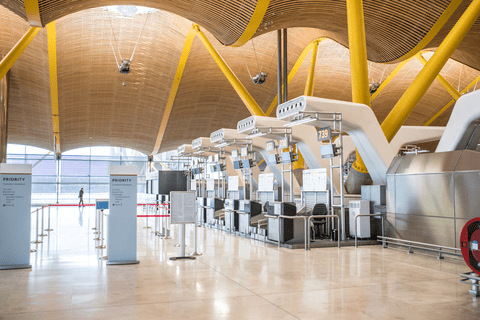If you’re teaching about global connections, COVID-19 offers a real-world case study with many different angles and perspectives. There’s a lot to consider when unpacking the evolving relationship between the current pandemic and globalization. We can consider the rapid worldwide spread of the disease, the economic fall-out of disrupted global activity, the ongoing scientific collaboration across countries, and the global inequalities that are unfolding as we race toward a new normal. Let’s explore…
COVID Went Around the World in a Few Weeks
With COVID-19 now active in almost every country on Earth, it can be hard to remember back to the early days of the pandemic when we first heard about the deadly virus circulating in China’s Hubei Province. It was only a matter of days before it became clear to scientists and citizens the world over that COVID-19 had the potential to spread easily and quickly, making it the “perfect storm” of viruses. It seemed like overnight we were dealing with the most globalized disease in history. Only 40 days after Wuhan went into lockdown, COVID-19 was declared a global pandemic and just 22 days later, there more that 1 million cases worldwide.
A couple of factors contributed to the rapid global spread, the most obvious being our interconnected world. In the “before-times” (pre-COVID), nearly 200,000 flights crisscrossed the world every day, people moved freely between borders, and the global supply chain chugged along un-interrupted. With so much global movement, it’s easy to see how germs easily hitched rides to far flung corners of the Earth. The specific characteristics of COVID-19 also contributed to the rapid global spread. The ability to be transmitted through asymptomatic carriers and to infect multiple people through casual contact allowed virus cases to quickly achieve exponential growth.

Empty airport terminal and check-in counters during COVID-19 lockdowns.
Our Interconnected Economy is Challenged by the Pandemic
As the coronavirus spread, the world quickly shut down. The number of daily flights plummeted, and it wasn’t just the movement of people that halted, but also often the movement of goods and money. Some fear that the rapid shuttering of borders, decreased tourism, and supply chain interruptions could reverberate through the global economy for years.
Back in April 2020, the World Trade Organization thought that COVID-19 could cause global trade to fall by as much as one-third. As the pandemic has played out, the data shows that those worst predictions didn’t materialize, with forecasts in October predicting a fall of 9.2 percent in 2020, followed by a rise of 7.2 percent in 2021. That being said, the impact on trade has been varied. According to the World Economic Forum, some countries, like China, have recovered quickly, while others, like the United States and Germany, still lag behind. In addition, some industries have done well (think electronics and facemasks, but also beef and bicycles) while others have seen steep declines (think cars and footwear). It is unclear what lies ahead in terms of global economic impacts, but economists agree that the post-COVID global economy will look different than that of 2019.
Quantifying the Global Impact of COVID-19
Despite significant impacts to the global economy, many point to the international collaboration that’s helped us fight the virus as evidence that globalization remains strong and is the key to emerging from this pandemic.
DHL, a leader in the Global Logistics industry, and the NYU Stern School of Business have quantified COVID’s impacts on globalization with their 2020 Global Connectedness Index. The index, which tracks international flows of trade, capital, information and people across 169 countries and territories, shows that although globalization took a hit in 2020, it has bounced back very quickly. This short video from DHL explains how global connectedness was impacted over this past year and ultimately, illustrates that the global ties that bind us are stronger than we may think. The sharing of knowledge and technology between countries has allowed scientists to develop vaccines and treatments faster than ever before, and strong global supply chains have enabled mass production and distribution of urgent medical supplies. We’ve also seen a steep rise in digital connectedness, paving the way for continued sharing of ideas and information.
Winners and Losers in the Race to a COVID-Free Future
But the question remains if all of this worldwide collaboration will continue as the world races to get vaccinated. Many signs, unfortunately, point to “no.” Already, there is a stark divide between countries that have access to the vaccine and those that do not. Despite warnings from health officials that we need to reach herd immunity among the entire world population (that’s 70% of 7.8 billion people) in order to defeat this pandemic, many wealthy countries are already hoarding vaccines, leaving poor countries last in line. Data from the Duke Global Health Innovation Center shows that high-income countries hold 4.2 billion doses while low- and middle-income nations hold just 670 million. At this rate, estimates show that low-income countries may be waiting until 2023 or 2024 before they have enough vaccine to reach herd immunity.
COVAX, an initiative of the World Health Organization, aims for every country to get fair and equitable access to vaccines, regardless of wealth. Many countries have contributed money to COVAX’s efforts – one of Biden’s first moves was to sign the U.S. onto COVAX and pledge $4 billion. But the group says they still need an additional $2 billion to meet their global vaccination target for 2021. And wealthy countries keeping vaccines for themselves certainly doesn’t help their effort.
What COVID Is Teaching Us About Our Globally Connected World
Ultimately, the battle with COVID-19 has taught us that there are wide-ranging benefits of having strong global connections. Despite international movement playing a role in COVID’s rapid spread, we’ve seen that our global economy depends on international partnerships and trade, that we’re all better off when we share ideas and technology around the world, and that strong global health requires unity and shared responsibility, not division. When we emerge, one day, from this global health emergency, we will need to rely on similar international partnerships to combat the many other global challenges, like climate change, that lie ahead.
Image Credits: Airport terminal (ID 96579961 © David Prado, Dreamstime.com); Woman at computer (ID 189287870 © Andrey Popov, Dreamstime.com)



